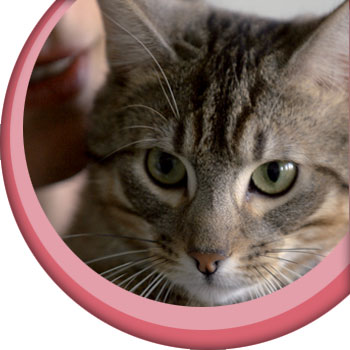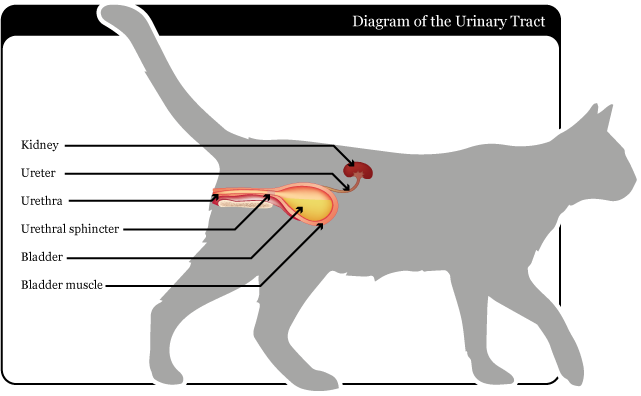Lower Urinary Tract
Disease in Cats
The lower urinary tract includes the bladder and the urethra (the tube which runs from the bladder to the outside world). Lower urinary tract disease is common in cats and can be split into two categories: cases where there is an obstruction to urination (when the cat cannot pass urine) and cases where there is no obstruction.


Non-obstructive
This condition usually involves inflammation of the lining of the bladder and can occur in both female and male cats. It is a condition that is not yet fully understood. The signs are similar to those which people suffer when they have cystitis but in cats there usually isn’t infection present. Most cases seem to be idiopathic which means that no cause is identified. It is thought that stress may be an important factor in triggering this condition, and cats that suffer from the condition will often have repeated episodes.
Signs you may notice include:
• Blood in the urine.
• Using their litter tray/going out more often.
• Straining to urinate or seeming uncomfortable.
• Urinating in other places around the house.
Although most cases of this condition appear to be idiopathic, there are other possible causes of the above signs which include:
• Urinary tract infection.
• Bladder tumours.
Your vet may therefore wish to carry out some investigations to make sure none of these other problems are present, which may include:
• Taking a urine sample to look for signs of inflammation and sending some away to a laboratory for a culture and sensitivity test to check for infection.
• Taking x-rays or performing an ultrasound scan to look for bladder stones or tumours.
If infection is found then appropriate antibiotics may be prescribed, and if tumours or stones are present your vet will discuss the best course of treatment with you. For idiopathic cases of lower urinary tract disease there is no specific treatment. Medication may be prescribed to try to reduce inflammation and make your cat more comfortable if necessary. Otherwise encouraging water intake and trying to minimise stress may help prevent recurrence of the condition. Environmental enrichment and/or behavioural modification may help. Some complementary therapies such as pheromone diffusers or dietary supplements may also help to support your cat through difficult times. If the situation is very severe, behavioural drugs may be required.
• Some cats prefer to drink from running water. You can buy special drinking fountains for them to encourage them to drink more.
• Some cats prefer water outside such as rainwater in a plastic dish.
• Having other cats that they don’t get on with, introducing new pets, moving house, or the presence of neighbouring cats may cause periods of stress. It often helps if your cat has somewhere quiet and safe to hide away if they need to. It is also worth speaking to your vet if you think your cat is stressed as they may be able to suggest other things to try.
It is important to bear in mind that some cats may urinate around the house for behavioural reasons. This may be if there is more than one cat in the household, if there are not enough litter trays (there should be one per cat plus a spare), or if they feel threatened by other cats in the neighbourhood. This is something you can discuss with your vet if you think it may be a problem for your cat. For more information on keeping your cat happy visit www.catanddogbehaviour.co.uk.
Obstructive
This occurs when a small stone or plug of mucoid material (firm mucus) blocks the urethra (tube from the bladder to the outside) and prevents your cat from urinating. It usually occurs in young male cats. It is a serious condition that can be life threatening as toxic substances may build up in the blood stream, and therefore you should visit your vet as soon as possible if your cat shows the following signs:
• Straining to urinate without passing anything.
• Licking around their back end and crying.
• Being off colour, lethargic or off their food.
When your vet examines your cat they may feel that his bladder is very full and firm. If they suspect that there is a blockage they will probably need to admit him to the surgery for treatment to relieve this and allow him to urinate again. They may also run blood tests to check whether he is dehydrated or if dangerous substances are building up in his blood, and put him on intravenous fluids (a drip) if this is the case. Once they have treated the obstruction they may send a urine sample away to find out what caused the problem and check for any infection. They will then be able to discuss further treatment and longer term management to try to prevent the condition recurring, and prescribe antibiotics if there is any infection. They may keep your cat in the surgery until they are happy he can pass urine by himself again.
Disclaimer: This website has been designed to offer information surrounding the use of antibiotics and infection control for pet owners. It does not replace advice from your veterinary surgeon. If you believe your pet is unwell or you have any questions relating to their treatment, please always contact your veterinary surgeon for advice.

